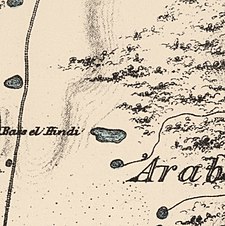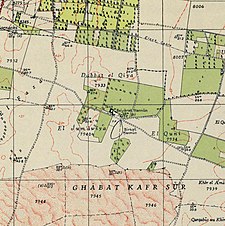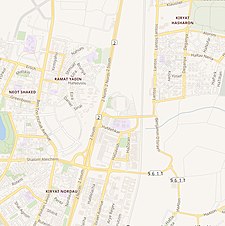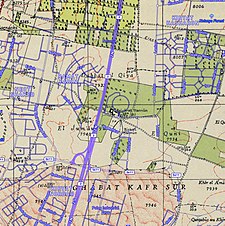Bayyarat Hannun
Bayyarat Hannun
بيارات حنون | |
|---|---|
Village | |
 Part of Bayyarat Hannun, during construction of Netanya Stadium | |
| Etymology: from Bayyara, meaning "orchard"[1] | |
A series of historical maps of the area around Bayyarat Hannun (click the buttons) | |
Location within Mandatory Palestine | |
| Coordinates: 32°17′36″N 34°51′48″E / 32.29333°N 34.86333°E | |
| Palestine grid | 137/188 |
| Geopolitical entity | Mandatory Palestine |
| Subdistrict | Tulkarm |
| Date of depopulation | Early April 1948[3] |
| Population (1931) | |
| • Total | 559 with Ghabat Kafr Sur and 'Arab el Balawina[2] |
| Cause(s) of depopulation | Fear of being caught up in the fighting |
| Secondary cause | Expulsion by Yishuv forces |
Bayyarat Hannun was a Palestinian Arab village in the Tulkarm Subdistrict in Mandatory Palestine. It was depopulated during "Operation Coastal Clearing" on March 31, 1948 in the 1947–48 Civil War in Mandatory Palestine. It was located 16 km west of Tulkarm.
Geography
Bayyarat Hannun was located on a small elevation, just north of an artificial pond. The most notable landmark was one large house, part of which was still standing in 1992.[1]
History
The first part of the name Bayyara, meaning "orchard", indicates that the village may have been established during the citrus boom in the area in the 1880s.[1]
The village was noted as a hamlet in the Palestine Index Gazetteer.[1]
In the 1931 census of Palestine it was counted with nearby Ghabat Kafr Sur and 'Arab el Balawina, together they had a population of 559; 6 Christians and 553 Muslims, in a total of 128 houses.[2]
Aftermath of the 1947–48 Civil War in Mandatory Palestine
The village became depopulated in early April 1948, during Operation Coastal Clearing carried out by Haganah. Benny Morris provided "fear of being caught up in the fighting" and "Expulsion by Yishuv forces" as reasons for depopulation,[3][4][5] while Rosemarie Esber noted "on-site massacre, atrocities, rape, expulsion by Zionist forces" as reason for depopulation.[6]
By 1992, the southern part of Netanya had expanded within 500 meters from the village site.[1]
References
Bibliography
- Esber, R.M. (2008). Under the Cover of War, The Zionist Expulsions of the Palestinians. Arabicus Books & Media. ISBN 0981513174.
- Khalidi, W. (1992). All That Remains: The Palestinian Villages Occupied and Depopulated by Israel in 1948. Washington D.C.: Institute for Palestine Studies. ISBN 0-88728-224-5.
- Mills, E., ed. (1932). Census of Palestine 1931. Population of Villages, Towns and Administrative Areas. Jerusalem: Government of Palestine.
- Morris, B. (2004). The Birth of the Palestinian Refugee Problem Revisited. Cambridge University Press. ISBN 978-0-521-00967-6.
External links
- Welcome To Bayyarat Hannun
- Bayyarat Hannun, Zochrot
- Survey of Western Palestine, Map 10: IAA, Wikimedia commons






